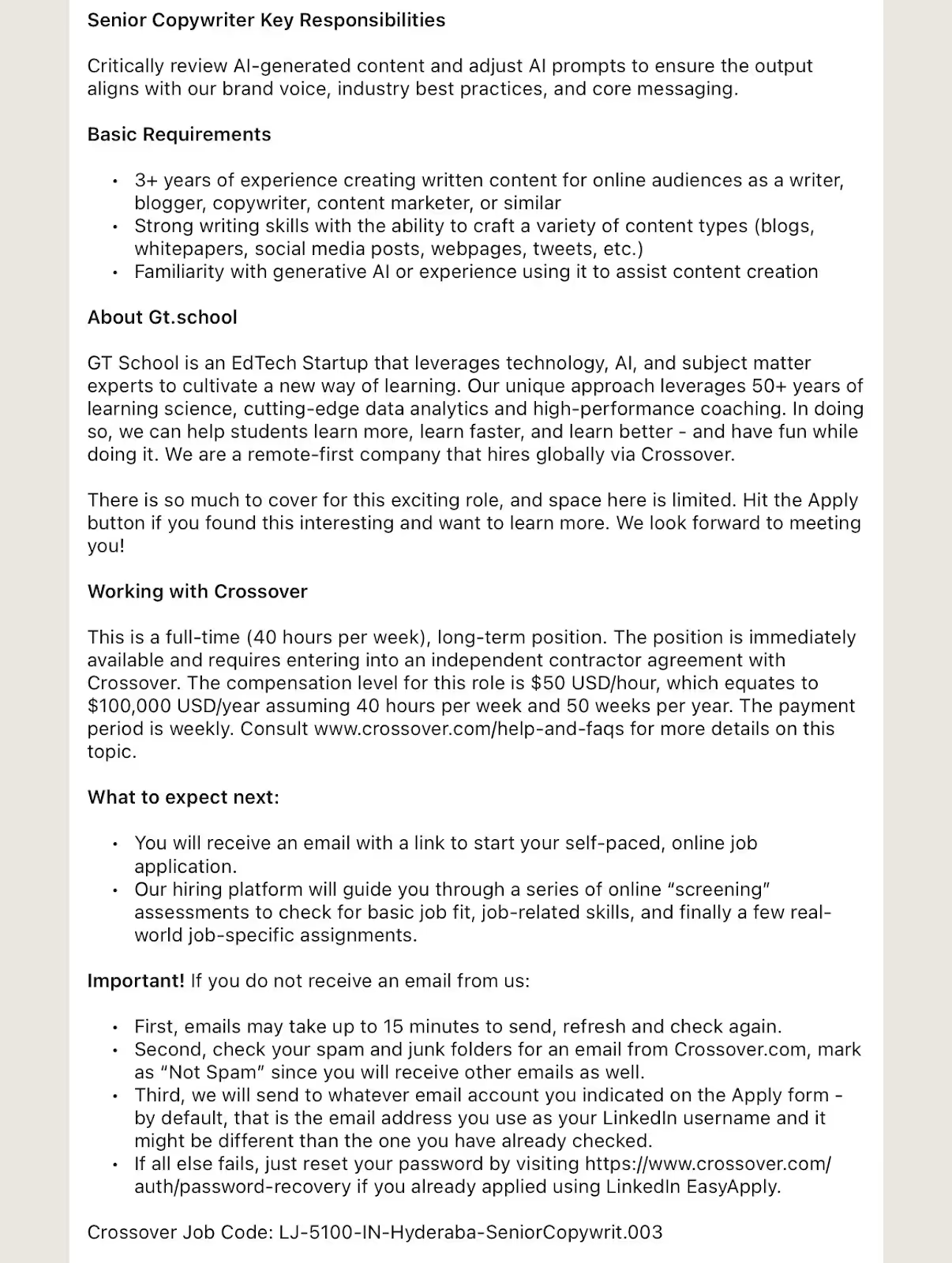Business growth is synonymous with more work and bigger challenges. This, in turn, requires an extra pair of hands. With several time-bound projects running, most businesses try to avoid the whole process of hiring full-time workers and rather hire a freelancer. Undeniably, hiring each full-time worker involves a lot of effort, hassle, and expense. So, let's understand the process of hiring a freelancer from scratch.
Freelancers work from anywhere in the world, shattering the constraints of a glass cubicle. They bring a unique set of advantages to businesses, right from cost effectiveness to flexibility.
Post-COVID, there has been a notable shift in the work structures. Remote work has gained dominance, and companies no longer treat working and hiring freelancers as an unconventional employment model. Employees are also fuelling this paradigm shift by embracing freelancing opportunities. Various industries are now actively hiring freelancers; according to statistics, the highest-paying freelance skills of today are copywriting, marketing, ads management, SEO consulting, lead generation, and sales.
In time, competition for freelancers will surge. Businesses must equip themselves with good hiring and onboarding practices to maintain and build quality relationships with freelancers.
{{international-employement="/components"}}
What is a freelancer?
A freelancer is a self-employed individual who offers professional services, typically in sectors like writing, programming, design, and marketing. Unlike traditional employees, freelancers work on a project-by-project basis for various clients. Freelancers bring specialized expertise, flexibility, and cost efficiency, enabling businesses to adapt rapidly to changing needs without the commitments associated with permanent staff. They are a versatile resource for projects requiring specific skills or temporary augmentation of the workforce.
Importance of hiring a freelancer
Although full-time employees bring more stability to the system as they are hired for permanent roles,, there are many scenarios where choosing to hire freelancers makes sense. Here is the list of reasons why:
- Short-term projects: Hiring a freelancer is a must-do for one-time projects. Post-project completion, there are no further obligations, which offers the employment relationship more flexibility for both parties.
- Need for global talents: Outsourcing freelancers allows you to choose from a vast global talent pool. Also, hiring freelancers from various countries creates connections across the globe, building networks and credibility for your company.
- Cost savings: Freelancers work on the pay-as-you-go model, which can be a less expensive choice. They are accountable for their holidays and sick pay and do not receive company benefits, which makes them cost significantly less than full-time employees.
- Specialized tasks: Freelancers provide highly specialized, on-demand. They can dedicate their full attention to providing specific services, particularly when your team lacks the particular skills for a given project.
- Low-skill tasks: Hiring freelancers can help complete routine and regular jobs like data entry or correction for which using in-house talent would not make sense from a monetary or an opportunity cost perspective. Outsourcing routine tasks will allow businesses to concentrate on what’s important, the core part of the business.
How to hire a freelancer?
Step 1. Establish the scope of your project
First and foremost, list the project needs and skills your current team lacks and create a freelancer brief. Establish the scope of work with all the requirements and expectations in place. This will help focus when assessing and shortlisting the candidates and give your freelance hire to start working from the get-go.
A good scope of work document will have the following:
- Objectives: Take note of the purpose of the project and the process of making it a success. List deliverables, terms, conditions, constraints, and anything else the freelancer should know.
- Skills needed: Mention the skills or expertise and minimum qualifications required to complete the work. Work experience is one indicator that can inform you about the quality of work they could deliver. If the project involves working with specific software or tools, look for candidates who have certifications to work on them.
- Budget: Keeping an eye on the financial investment required while hiring a freelancer is essential, as it plays a crucial role in the quality and professionalism it delivers. Freelancers are considered independent contractors, so employer benefits and overhead costs aren’t counted. The average rate for hiring a freelance professional varies depending on the geographical location and experience level. Explore job listing websites or freelance marketplaces to get an idea of the average industry standard rate for the work you are hiring for.
Step 2. Create a job description
A more targeted job description will streamline the recruitment funnel and filter out unsuitable candidates at the entry-level. The job description typically outlines what skills, experience, and qualifications you seek and other core components like salary and benefits. Aim for scannable job descriptions that share a basic understanding of what candidates want to know.
Here’s how a good job post should look like

Here’s how a job post shouldn’t look like

Step 3. Post the job and hire online
Several online platforms have made it easier for employers to hire freelancers. Some portals are niche and specific to particular kinds of job industries. Depending on your hiring needs, here are some of the best places to find freelancers:
- Freelancer platforms - Dedicated freelancing platforms like Upwork, Fiverr, and Guru will let you hire freelancers in a more streamlined way.. As a user, you can post jobs, explore freelancers’ profiles, assess their reviews, and choose freelancers based on the skills you are looking for.
- Through Portfolio sites - Portfolio sites like Behance, Dribble, and GitHub are the best places for creative talents to showcase their designs and get hired. It’s also where many employers visit to hire freelancers or full-timers, especially for design jobs. These sites also let employers bookmark designers for future project needs. It also offers recommendations of profiles based on the requirements.
- Social Networks - Social media platforms like LinkedIn, Twitter, and Glassdoor are gaining popularity in the freelance market. It helps find qualified freelancers via search and filter options. You can also look for relevant social media groups or networks to ask your connections for recommendations.
- Job posting sites - Indeed and Naukri are some of the job posting sites you can consider for hiring freelancers. These platforms can cater to various audiences seeking various employment opportunities.
Step 4. Evaluate and Screen the applicants
Now that you have a list of candidates, you can start filtering and interviewing the most skilled applicants. Here is the list of steps you could follow to screen the applicants:
Shortlist top performers with online skill assessments
On average, one job post receives 250 applications. This figure is even higher, especially if you are open to hiring remotely. Translating your requirements into skill assessments will help make the first level of filtration. Instead of testing every candidate personally, these online skill assessment tests will help you filter candidates in bulk. The assessment can include both technical and soft skill tests.
Review their portfolio
Experienced freelancers often have portfolio websites where they display their past projects. Work samples and portfolios will give an even better picture of their creative talents and showcase their best work. Look out for the diversity in the range of companies they have worked with.. Also, make sure you run a background check before hiring freelancers.
Conduct an interview
Interviews are the best way to talk to your candidates and understand if your expectations align. As most freelancers work remotely, video interviews are the only way to meet and assess them. Connect with the freelancers you think are best suited for the job. Look for a history of successful problem-solving in their previous projects, as the ability to address and overcome challenges is a vital skill necessary for any freelancer to be hired.
Discuss payment structure
Every project or role should have a range of possible payment rates. The complexity of work, urgency, availability of resources, and experience sum up the target rate for the freelancer. Freelancer rates also vary greatly depending on the geographic location. So, depending upon the nature of the project and the agreement between the employer and the freelancer, they get paid for the work they complete within a fixed time. There are two standard methods of payment.
Time-based pay: For every hour worked, freelancers charge their income. This provides information on their work for the total number of hours. Timesheets or time-tracking tools can be used to monitor their working hours.
Project-based pay: Some freelancers commit to project-based payment, where they are set with a fee for the entire project. With a clear picture of the tasks and deliverables, this method ensures a steady income for every project that’s been completed.
{{hiring-power="/components"}}
Step 5. Set ground rules
Setting clear expectations from the beginning allows employers and freelancers to discuss their needs and inputs. This helps avoid confusion later in the project.
Mission of the project/company
When you hire a freelancer for the first time, they must understand your project and the company. With this, they can incorporate your values into the work they deliver. Give a deep understanding of your core products, services, organizational goals, and any other information you think is relevant to helping them know your business. Feeding them with the correct information will save a valuable amount of time later.
Communication methods
As the freelancer’s job is remote, poor communication can affect the quality of work. Therefore, work with freelancers who respond proactively..
Schedules & Deadlines
Clear communication about the delivery dates will avoid last-minute hassles. A project can be set with key milestones to be achieved and can be reviewed upon the completion of every milestone. This will help sort out the inconsistencies or errors then and there.
Termination policy
Include a confidentiality clause to protect against sensitive information and specify the ownership of any intellectual property created during the project, such as copyright or patent. Outline the conditions under which the Contract will be canceled or terminated when one party fails to fulfil their contractual obligations.
Feedback and iteration policy
Follow-ups are part and parcel of working. To ensure smooth working progress and timely delivery, it is essential to provide constructive feedback then and there. Divide the work into stages while dealing with large projects and review each step. This will allow freelancers to sink in with the company’s expectations.
Best practices when hiring a freelancer
Once the screening process is complete, the potential candidates are hired based on their performance. Post-hiring, there is a separate onboarding process where the company undertakes a series of procedures to integrate the newly hired freelancer into the company.
1. Create a clear and detailed freelancer agreement
A contract is a legally binding agreement that provides a solid foundation, fostering a transparent and mutually beneficial working relationship between the client and freelancer.
- Specifying a clear scope of work, deliverables, timeline, and payment terms ensures clarity over the project.
- Include confidentiality clauses to protect sensitive information and termination clauses with applicable penalties or fees.
- Finally, it addresses legal aspects such as dispute resolution mechanisms and jurisdiction.
2. Provide detailed invoice processing steps
Companies should provide clear instructions on guiding freelancers in creating invoices specifying essential details. Clearly outline invoice date and due date for prompt payment. Break down the services provided, detailing each task with corresponding prices. Also, mention payment terms and preferred payment methods and encourage freelancers to include a brief project summary. This way, financial transactions can be streamlined.
3. Set payroll cutoff dates
Communicate to freelancers in advance about payroll cutoff dates. When hiring freelancers globally, it's crucial to establish clear payroll cutoff dates to ensure timely and organized payment. This involves setting specific dates each month by which freelancers must submit invoices to guarantee processing within the payment cycle. Remember to account for time zone differences and local holidays affecting invoicing and payment timelines. Establishing a structured payment schedule not only streamlines your financial operations but also builds trust with freelancers, fostering a reliable and professional working relationship.
How can a Global EOR help?
Hiring a freelancer will reduce your team's workload and help improve business efficiency at a comparatively low cost. But post-hiring, the onboarding phase becomes a crucial one.
Gloroots, a premier global EOR, is your golden key to hiring and paying freelancers in a streamlined manner. Gloroots helps you automate compliant freelancer contract generation and help manage a broad spectrum of core HR tasks to ensure compliance with local employment and tax regulations.
Gloroots has made global employment simple and scalable, ensuring businesses stay compliant and thrive globally. Embrace a smooth onboarding journey and focus on your core business, leaving the rest with us. Globalize with Gloroots. Join us today!

.webp)




























.webp)


















.avif)





.webp)

.svg)
.webp)


.webp)












